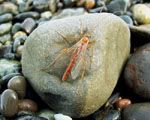Since many of you are now learning to tie and make your own jigs, the next big savings to learn to do is; "how" to make and use cheap bobber's that you can retrieve time after time when your jigs get hung up!
Not that long ago, I wrote an article explaining to you how to use a secret killer method to catch coho with jigs. Apparently a lot of our board members enjoyed my tread and said that they would be trying out this new method this coming fall. Recently another board member (Dogfish) also posted a very informative article on how to tie your own steelhead jigs (great job Dogfish!).
When I first started fishing bobbers and jigs about 4 years ago, I was consistently loosing anywhere from 3 to 8 bobbers a day, especially after fishing in areas that new snags had washed into after having the usual high water events. The lost of bobbers even became greater when I fished a new stream or new section of water that I had not fished before. Now, it's rare that I even loose a single bobber during a trip! For the "bobber and jig" fishermen who likes to fish this way, there still remains one costly hurdle that he needs to learn how to jump; It's called the art of getting you're hung up bobbers back!
Some of you may have already seen or used this new method, but only a handful of us have developed and perfected its use. Few fishermen up to this time have been willing to share the secret of how you can fish almost all day long with out loosing a single bobber. Furthermore, if you are one of those "hard pinched" guys who can't afford to spend a lot of money on bobbers, you will fully enjoy what I am about to reveal.
In the following paragraphs I will explain to you;
1) How to the make the "bobber".
2) How to rig the "bobber"
.
3) The "secret" trick to recovering your bobbers!
Are ready?
To start with, I prefer to use a #2 Beau Mac Cheater for my bobbers, especially if I am using a 1/32, 1/16 or 1/8 oz jigs head size. Larger bobber sizes may also be used for this same method if you prefer too, but I personally prefer using the #2 cheaters. Others may prefer to use this method on the larger size high condensed foam, or the larger size cork bobbers; it really doesn't matter because they will all work well with my "trick method"!
There are basically 3 reasons why I prefer using these large Beau Mac # 2 "cheaters":
1) They are cheap! If you buy them in the bulk directly from Beau Mac at wholesale price they will run you about 17 cents each (bags of 100 or more). If you buy them at retail price, you can get 2-3 for about a dollar.
2) They come in a huge assortment of pre-painted bright colors that are great for seeing in all light conditions.
3) Some of the colors even come in "glow in the dark" florescent material, which makes them great for night fishing.
The first picture below shows the 2 basic ways that I prefer to use the "cheater" bobbers for. The first bobber is #2 cheater that "glows in the dark", with a single factory made hole for your line to run through. The second cheater-bobber is just like the first one except it is used in conjunction with a tooth pick that is used to hold your line in place at any depth that you may wish to set it at. This is the most commonly used method for the guys that use these cheaters for bobbers, and is also the main reason why most bobber fishermen loose their bobbers. The third cheater-bobber is the "trick" one!
#1: Making the "bobber"; I recommend that you use an 11/64 drill bit size to drill out the center hole of you bobber. The drill size will depend on the size of the bobber pins that you use. I have found that 90% the bobber pins that I have seen will require the use of the 11/64 drill bit size. The rule of thumb is; you do not want your bobber pin to go much farther down inside your bobber then ¾ of the lenght of the bobber pin. Make sure that you do not over drill the dept of the bobber pin (only drill it the lenght of the pin). If you choose to use larger bobber pins then normal, you may want to increase the drill size just a hair.
90% of the time, the 11/64 drill size will work just fine. Again, I recommend that you do not drill the hole any deeper then the lenght of the bobber pin though your bobber. The reason for not drilling the hole all the way through your bobber is; if you do not drill the hole all the way through, the bobber may still be used with the "tooth pick" method simply by turning the bobber upside down and using the tooth pick as your stopper pin. If you drill the 11/64 hole all the way through, you will not be able to use the tooth pick option. Always make sure that when you finish drilling your pin holes that you always blow out the loose foam or cork dust so that your line can still run though the original cheaters hole!
There will be curtain times when fishermen will want to use either the tooth pick method or my trick pin method. Next, you will need to purchase the bobber pins (see bobber #3 in picture #1). Make sure that the bobber pin has a HOLE in the center of it so that it allows you to run your line all the way though the middle of the pin. Most good tackle shops carry extra bobber pins. Make extra sure that you do not buy pins without the pre drilled holes in them unless you want to drill them out yourself (it's a real pain in the rear to do that!).
Picture 1

Picture 2

Picture 3

#2 (Rigging the bobber); after you have drilled the 11/64 hole about ¾ of the way through, you will need to run your fishing line through the middle of the bobber pin and all the way through the bobber (see bobber#1 in picture #3). Next, you will need to tie on your favorite jig onto the end of your line. Remember, the #2 cheaters only work well on jigs that weight 1/8 oz or less. After you have tied your jig on, select the depth that you want your jig to float at. Hold your bobber with one hand and then use your other hand to take the pin that has the line running through it and make a small loop in front of the pin, just above the front of the top of your bobber (see picture #2). Next, gently push the pin and the loop right back into the top of the bobber hole (see bobber# 3 in picture #2) until it is firmly in. Do not over push, or use excessive pressure when you press the pin back into the bobber. Too much pin pressure will not allow you to pull loose the bobber pin loose when your jig gets a hang-up! Do a couple of tests by holding your jig in one hand and then pulling the line above the bobber. The Pin and loop should come out by the use of just a firm snug pull. If not, you had used to much pressure, and you need to reset your pin (see #3 bobber in picture #2). Once you have perfected this pin and loop method, you will be able to change the dept of your jig in just a few seconds
#3 (the secret trick); here's the trick. If you're a straight line bobber and jig fishermen like me, (that means that your main line goes directly through your bobber and ties directly to your jig) you're going to loose bobbers! How many times have you tried to cast your bobber into that perfect spot and found seconds later that there was that surprised limb hanging out there that just jumped right out and grabbed your jig, leaving your bobber just hanging at the mercy of the great river gods? How many times have you hung up your jig, just to watch your bobber break off and feed the guys who are fishing downriver?
9 times out of 10, your line will break off at your bobber or jig, and down river goes your best or last bobber! If you're one of those bobber and jig straight line (8lb) fishermen like me, there is no way in hell that you will ever get that bobber back before your line breaks first. Here's where this trick works; if your bobber and jig gets permanently hung up, you will need to walk down and get just about even with (facing the snag in front of you) or a few feet below the snag. Next, you need to let out enough free line so it will allow your bobber to "float" about 25 feet or more down below the snag point. You will need to let your bobber float down to at lease the distance that you are stading from the snag.
Once the bobber has caught up to your slack line, and is about 25 feet or so down river, you need to lower your rod tip to water and start a series of rapid full fast upward side jerking motions back up river. You will see your bobber starting to jump up and into the air when you are doing this right. Keep the jerking and winding of your line in until your bobber bounces back to where either you can grab it by your hand, or by holding your line in one hand (keep it pretty tight) and then reaching out using your rods tip to get behind the back side (top) where your bobber pins was, and then slide your rod tip inwards until to can reach out and grab your bobber. It's pretty easy to use your rod tip to do this, and slide your bobber the rest of the way in so that you can then reach out and grab it.
It will take you a few practice times to refine this part of the trick, but once you have figured it out you will not be buying a lot of new bobbers anymore. One final point; always make sure that when you start this "fast upward Jerking" motion, that you have enough room above and beside you to make the full jerking motion of your rod without hitting any overhanging tree limbs that may be near you. A bobber is not worth a broken rod tip!
There is one final advantage and benefit that this method gives the fishermen. You will always be able to track where your fish is heading because the bobber will stay right on top of the water instead of being pulled under by a fighting fish; and that just means one less thing to get snaged up!
Ps, this same method works great when you want to use bait, instead of a jig!!
Good luck and good fishing!
Cowlitzfisherman

























 Previous Topic
Previous Topic Index
Index

